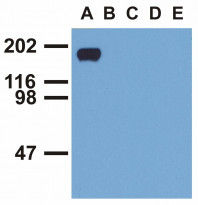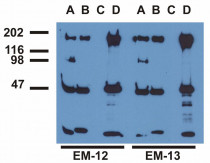ARG53931
anti-EGFR phospho (Tyr992) antibody [EM-12]
anti-EGFR phospho (Tyr992) antibody [EM-12] for Flow cytometry,Immunoprecipitation,Western blot and Human
Cancer antibody; Signaling Transduction antibody
Overview
| Product Description | Mouse Monoclonal antibody [EM-12] recognizes EGFR phospho (Tyr992) |
|---|---|
| Tested Reactivity | Hu |
| Tested Application | FACS, IP, WB |
| Specificity | The clone EM-12 reacts with human EGFR (ErbB1 / HER1) phosphorylated on tyrosine 992. |
| Host | Mouse |
| Clonality | Monoclonal |
| Clone | EM-12 |
| Isotype | IgG1 |
| Target Name | EGFR |
| Antigen Species | Human |
| Immunogen | Synthetic phospho-peptide covering sequence around tyrosine 992 of human EGFR. |
| Conjugation | Un-conjugated |
| Alternate Names | PIG61; ERBB1; Proto-oncogene c-ErbB-1; Receptor tyrosine-protein kinase erbB-1; NISBD2; Epidermal growth factor receptor; ERBB; HER1; EC 2.7.10.1; mENA |
Application Instructions
| Application Suggestion |
|
||||||||
|---|---|---|---|---|---|---|---|---|---|
| Application Note | * The dilutions indicate recommended starting dilutions and the optimal dilutions or concentrations should be determined by the scientist. | ||||||||
| Positive Control | WB: Positive control: EGF-stimulated A431. Negative control: Non-stimulated A431. |
Properties
| Form | Liquid |
|---|---|
| Purification | Purified from hybridoma culture supernatant by protein-A affinity chromatography. |
| Purity | > 95% (by SDS-PAGE) |
| Buffer | PBS (pH 7.4) and 15 mM Sodium azide |
| Preservative | 15 mM Sodium azide |
| Concentration | 1 mg/ml |
| Storage Instruction | For continuous use, store undiluted antibody at 2-8°C for up to a week. For long-term storage, aliquot and store at -20°C or below. Storage in frost free freezers is not recommended. Avoid repeated freeze/thaw cycles. Suggest spin the vial prior to opening. The antibody solution should be gently mixed before use. |
| Note | For laboratory research only, not for drug, diagnostic or other use. |
Bioinformation
| Database Links | |
|---|---|
| Gene Symbol | EGFR |
| Gene Full Name | epidermal growth factor receptor |
| Background | EGFR is a transmembrane glycoprotein. It is a member of the protein kinase superfamily. This protein is a receptor for members of the epidermal growth factor family. EGFR is a cell surface protein that binds to epidermal growth factor. Binding of the protein to a ligand induces receptor dimerization and tyrosine autophosphorylation and leads to cell proliferation. Mutations in this gene are associated with lung cancer. [provided by RefSeq, Jun 2016] |
| Function | EGFR: Receptor tyrosine kinase binding ligands of the EGF family and activating several signaling cascades to convert extracellular cues into appropriate cellular responses (PubMed:2790960, PubMed:10805725, PubMed:27153536). Known ligands include EGF, TGFA/TGF-alpha, AREG, epigen/EPGN, BTC/betacellulin, epiregulin/EREG and HBEGF/heparin-binding EGF (PubMed:2790960, PubMed:7679104, PubMed:8144591, PubMed:9419975, PubMed:15611079, PubMed:12297049, PubMed:27153536, PubMed:20837704). Ligand binding triggers receptor homo- and/or heterodimerization and autophosphorylation on key cytoplasmic residues. The phosphorylated receptor recruits adapter proteins like GRB2 which in turn activates complex downstream signaling cascades. Activates at least 4 major downstream signaling cascades including the RAS-RAF-MEK-ERK, PI3 kinase-AKT, PLCgamma-PKC and STATs modules (PubMed:27153536). May also activate the NF-kappa-B signaling cascade (PubMed:11116146). Also directly phosphorylates other proteins like RGS16, activating its GTPase activity and probably coupling the EGF receptor signaling to the G protein-coupled receptor signaling (PubMed:11602604). Also phosphorylates MUC1 and increases its interaction with SRC and CTNNB1/beta-catenin (PubMed:11483589). Plays a role in enhancing learning and memory performance. Isoform 2 may act as an antagonist of EGF action. (Microbial infection) Acts as a receptor for hepatitis C virus (HCV) in hepatocytes and facilitates its cell entry. Mediates HCV entry by promoting the formation of the CD81-CLDN1 receptor complexes that are essential for HCV entry and by enhancing membrane fusion of cells expressing HCV envelope glycoproteins. [UniProt] |
| Highlight | Related Antibody Duos and Panels: ARG30238 Phospho EGFR Antibody Duo (Total, pY992) Related products: EGFR antibodies; EGFR ELISA Kits; EGFR Duos / Panels; Anti-Mouse IgG secondary antibodies; |
| Research Area | Cancer antibody; Signaling Transduction antibody |
| Calculated MW | 134 kDa |
| PTM | Phosphorylation at Ser-695 is partial and occurs only if Thr-693 is phosphorylated. Phosphorylation at Thr-678 and Thr-693 by PRKD1 inhibits EGF-induced MAPK8/JNK1 activation. Dephosphorylation by PTPRJ prevents endocytosis and stabilizes the receptor at the plasma membrane. Autophosphorylation at Tyr-1197 is stimulated by methylation at Arg-1199 and enhances interaction with PTPN6. Autophosphorylation at Tyr-1092 and/or Tyr-1110 recruits STAT3. Dephosphorylated by PTPN1 and PTPN2. Monoubiquitinated and polyubiquitinated upon EGF stimulation; which does not affect tyrosine kinase activity or signaling capacity but may play a role in lysosomal targeting. Polyubiquitin linkage is mainly through 'Lys-63', but linkage through 'Lys-48', 'Lys-11' and 'Lys-29' also occurs. Deubiquitination by OTUD7B prevents degradation. Ubiquitinated by RNF115 and RNF126 (By similarity). Methylated. Methylation at Arg-1199 by PRMT5 stimulates phosphorylation at Tyr-1197. |
Images (3) Click the Picture to Zoom In
-
ARG53931 anti-EGFR phospho (Tyr992) antibody [EM-12] WB image
Western blot: A. EGF-treated A431 cell lysate, B. CALU-3 cell lysate, C. MCF-7 cell lysate, D. Jurkat cell lysate, E. RAMOS cell lysate stained with ARG53931 anti-EGFR phospho (Tyr992) antibody [EM-12].
-
ARG53931 anti-EGFR phospho (Tyr992) antibody [EM-12] IP image
Immunoprecipitation: EGF-treated A431 cell was immunoprecipitated with (A) ARG53931 anti-EGFR phospho (Tyr992) antibody [EM-12], (B) EM-13 antibody, (C) anti-EGFR commercial polyclonal antibody, (D) anti-EGFR monoclonal mAb108 antibody. The precipitates were stained with EM-12 or EM-13 antibody.
-
ARG53931 anti-EGFR phospho (Tyr992) antibody [EM-12] IP image
Immunoprecipitation: EGF-treated A431 cell was immunoprecipitated with (A) ARG53931 anti-EGFR phospho (Tyr992) antibody [EM-12], (B) EM-13 antibody, (C) anti-EGFR commercial polyclonal antibody, (D) anti-EGFR monoclonal mAb108 antibody. The precipitates were stained with commercial anti-EGFR polyclonal antibody.










